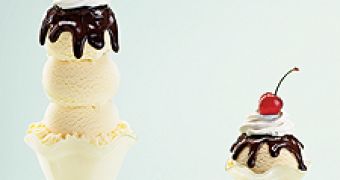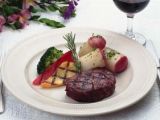One thing that's easy enough to overlook is that it's not enough to eat the right type of food, it's extremely important to make sure you eat the correct amount, too. The size of the portions we eat has a direct impact on our nutrient and calorie intake and affects our weight and overall state of health just as much as the types of food we put on our plates. It's extremely important, doctors say, to avoid large helpings of high-calorie foods and to eat more of the good stuff - low-calorie food such as fruit and vegetables.
For those of you who never considered portion control so far, are reluctant about buying scales and feel that weighing food would take the fun out of eating, the nutritionists of the prestigious Mayo Clinic have come up with a series of what they call "everyday equivalents" for portion sizes. The point is to make things simpler, not more complicated - and the system they propose for judging serving sizes may be the ideal first step in the right direction. Here is the Mayo Clinic rough guide to portion control, applied to the various food types and groups.
1. Grains
A serving of cooked macaroni = 1/2 cup (think of the size of an ice-cream scoop) Cooked pasta or oatmeal = 1/2 cup Whole-wheat bread = 1 slice Whole-wheat crackers = 6 whole
2. Fruit
One serving = one cup (about the size of a tennis ball) mixed berries, cherries or cantaloupe cubes Apple, pear or banana = 1 small fruit 100 % fruit juice = 1/2 cup
3. Vegetables
One serving = 1/2 cup cooked carrots Raw leafy vegetables = 2 cups Raw vegetables, chopped = 1 cup Chopped, cooked or canned vegetables = 1/2 cup
4. Dairy products
One serving of low-fat cheddar cheese = 2 ounces (about the size of two dominoes) Low-fat / fat-free milk or yogurt = 1 cup Mozzarella cheese (part-skimmed) = 1 1/2 ounces (about 1/3 cup shredded)
5. Meat and beans
One 3-ounce serving of fish = about the size of a deck of cards. Poultry / fish (cooked skinless) = 3 ounces Cooked lean meat = 1 1/2 ounces Cooked legumes or dried beans = 1/2 cup (the size of an ice cream scoop) Egg = 1 medium
Remember - as long as you stay in firm control of the type and the amount of food that you eat, there's nothing stopping you from embarking on a fitness regime to match your ultimate purpose, whether we're talking about losing weight, lowering your cholesterol or simply maintaining your present weight while struggling to balance a hectic job, a family and a healthy lifestyle.

 14 DAY TRIAL //
14 DAY TRIAL // 
